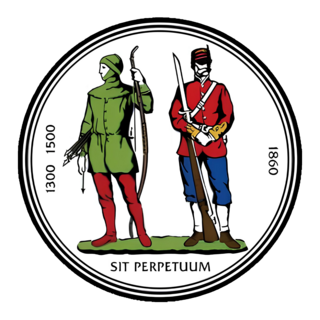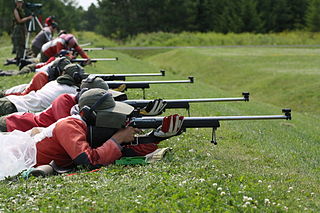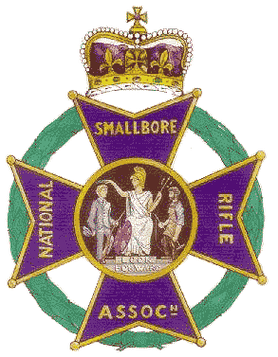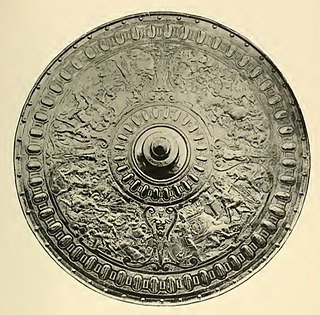
The National Rifle Association (NRA) is the governing body for full bore rifle and pistol shooting sports in the United Kingdom. The Association was founded in 1859 with the founding aim of raising funds for an annual national rifle meeting to improve standards of marksmanship. Today the NRA continues this objective as well as organising civilian target shooting and selecting British teams to contest the ICFRA World Championships. The National Shooting Centre at Bisley is a wholly owned subsidiary of the association.

Thomas Francis Fremantle, 3rd Baron Cottesloe, 4th Baron Fremantle was a British peer and rifle shooter. Regarded among the foremost marksmen of his day, he competed for Great Britain in the 1908 Summer Olympics, and captained Great Britain in several international matches. He was also a long-time member of the English Eight Club, shooting, coaching and captaining England in the Elcho match for a total of more than sixty years.

Fullbore target rifle (TR) is a precision rifle shooting-sport discipline governed by the International Confederation of Fullbore Rifle Associations (ICFRA). TR uses single-shot rifles, usually chambered in .308 calibre, with circular "bullseye" targets at distances of 300–1000 yards. The term "fullbore" refers to the relatively large centerfire calibres used. In contrast, smallbore rifle shooting uses firearms chambered for relatively low-powered rimfire cartridges.

The National Small-bore Rifle Association (NSRA) is the national governing body for all small-bore rifle and pistol target shooting in the United Kingdom, including airgun and match crossbow shooting.
The Elcho Shield is an annual long range shooting competition between national teams of eight from England, Scotland, Ireland and Wales. The trophy holder was originally able to choose the venue of the competition, however, since the NRA's move to Surrey from Wimbledon in 1890, the competition has been held at National Shooting Centre, Bisley in Surrey, England. It is usually contested during the NRA Imperial Meeting.
Parag Patel FRCS is a British sport shooter who works as an ear, nose and throat consultant at Kingston Hospital in London.

The National Shooting Centre, commonly referred to as Bisley, is the UK's largest shooting sports complex, comprising several shooting ranges as well as the large Bisley Camp complex of accommodation, clubhouses and support services. The centre is located between the villages of Bisley and Brookwood in Surrey. The site is wholly owned by the National Rifle Association (NRA).

Andrew St George Tucker (1937–2003) was a Scottish-born, sports shooter who represented England and Great Britain shooting smallbore and fullbore target rifle. He won the Queen's Prize at Bisley twice, medalled at the 1990 Commonwealth Games in Auckland as well as winning the NSRA Lord Roberts Trophy for smallbore, He also won the Grand Aggregates at both the NRA Imperial Meeting and NSRA National Smallbore Meeting. He is the first and only person to win the "big four" of both British titles and both Grand Aggregates. He ran Andrew Tucker Gunsmiths, manufacturing firearms and target shooting equipment including jackets, rifle slings and gloves.

The Ashburton Shield is an historic trophy for target rifle shooting in the British Isles. It is awarded annually to the winning team of VIII at the Schools' Meeting, held at Bisley by the National Rifle Association. The competition is open to teams of cadets from, predominantly, Combined Cadet Force units based in public and private schools.

The Sovereign's Prize, referred to as the Queen's Prize or the King's Prize depending on the incumbent British monarch, is the oldest fullbore target rifle shooting competition and is widely regarded as one of the most prestigious prizes in the sport globally. Founded in 1860, it was originally held annually on Wimbledon Common in London. The competition later moved to the purpose-built Bisley Camp where it is still held today.
This article lists the main target shooting events and their results for 2018.
This article lists the main target shooting events and their results for 2019.
This article lists the main target shooting events and their results for 2014.
This article lists the main target shooting events and their results for 2010.
This article lists the main target shooting events and their results for 2021.
This article lists the main target shooting events and their results for 2017.
This article lists the main target shooting events and their results for 2016.
This article lists the main target shooting events and their results for 2013.
This article lists the main target shooting events and their results for 2012.
The sport of rifle shooting at Cambridge University has been practised since at least the early 19th century. Beginning as part of the military training of the Cambridge University Rifle Volunteers, it has since been conducted by a number of student clubs, and is currently carried out predominantly by the Cambridge University Rifle Association and Cambridge University Small Bore Club, with some participation by the Cambridge University Revolver and Pistol Club for the discipline of gallery rifle.











